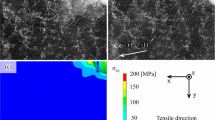Abstract
Integrating in situ deformation and electron tomography (ET) techniques allows us to visualize the materials’ response to an applied stress with nanometer spatial resolution. The capability of structural, chemical, and morphological characterization in three-dimension real time and at sub-microscopic levels alleviates several persistent problems of two-dimensional imaging such as the projection effect and postmortem appearance. On the other hand, implementing deformation mechanism introduces additional experimental constraints that could influence the accuracy of the reconstructed volumes in a different way. To materialize quantitative and statistically relevant microstructure interpretation by time-resolved ET, we evaluated several key parameters such as angular tilt range, tilt increment, and reconstruction algorithms to characterize their influences on the accuracy of size and morphology reproducibility.









Similar content being viewed by others
References
1 J. Kacher, G.S. Liu, and I.M. Robertson: Micron, 2012, vol. 43, pp. 1099–107.
2 J. Jung, J. Lee, H.-W. Park, T. Chang, H. Sugimori, and H. Jinnai: Macromolecules, 2014, vol. 47, pp. 8761–7.
3 B. Hudson: J. Microsc., 1973, vol. 98, pp. 396–401.
4 E. Oveisi, A. Letouzey, D.T.L. Alexander, Q. Jeangros, R. Schäublin, G. Lucas, P. Fua, and C. Hébert: Sci. Rep., 2017, vol. 7, p. 10630.
5 B. Modéer: Scr. Metall., 1974, vol. 8, pp. 1145–52.
6 J.S. Barnard, J. Sharp, J.R. Tong, and P.A. Midgley: Philos. Mag., 2006, vol. 86, pp. 4901–22.
7 W. Baumeister, R. Grimm, and J. Walz: Trends Cell Biol., 1999, vol. 9, pp. 81–5.
8 S. Hata, S. Miyazaki, H. Miyazaki, T. Gondo, K. Kawamoto, N. Horii, K. Sato, H. Furukawa, H. Kudo, and M. Murayama: Microscopy, 2016, vol. 66, pp. 143–53.
9 N. Kawase, M. Kato, H. Nishioka, and H. Jinnai: Ultramicroscopy, 2007, vol. 107, pp. 8–15.
10 D.N. Mastronarde: J. Struct. Biol., 1997, vol. 120, pp. 343–52.
11 S. Hata, H. Miyazaki, S. Miyazaki, M. Mitsuhara, M. Tanaka, K. Kaneko, K. Higashida, K. Ikeda, H. Nakashima, S. Matsumura, J.S. Barnard, J.H. Sharp, and P.A. Midgley: Ultramicroscopy, 2011, vol. 111, pp. 1168–75.
12 R. Leary, Z. Saghi, P.A. Midgley, and D.J. Holland: Ultramicroscopy, 2013, vol. 131, pp. 70–91.
13 Z. Saghi, G. Divitini, B. Winter, R. Leary, E. Spiecker, C. Ducati, and P.A. Midgley: Ultramicroscopy, 2016, vol. 160, pp. 230–8.
14 K. Sato, H. Miyazaki, T. Gondo, S. Miyazaki, M. Murayama, and S. Hata: Microscopy, 2015, vol. 64, pp. 369–75.
15 P.A. Midgley and M. Weyland: Ultramicroscopy, 2003, vol. 96, pp. 413–31.
16 G.T. Herman and R. Davidi: Inverse Probl., 2008, vol. 24, p. 45011.
17 K. Sato, K. Aoyagi, and T.J. Konno: J. Appl. Phys., 2010, vol. 107, p. 24304.
Acknowledgments
The microscopy was carried out in the Nanoscale Characterization and Fabrication Laboratory, Institute for Critical Technology and Applied Science, Virginia Tech. The authors would like to acknowledge Dr. W. T. Reynolds Jr. (Virginia Tech), Dr. Satoshi Hata (Kyusyu University) for their constructive discussion. Y. Y. was financially supported by the Virginia Tech National Center for Earth and Environmental Nanotechnology Infrastructure (NanoEarth), a Member of the National Nanotechnology Coordinated Infrastructure (NNCI) supported by NSF (ECCS 1542100). Funding for this project was partly provided by DOE BES Geosciences (DE-FG02-06ER15786).
Author information
Authors and Affiliations
Corresponding author
Additional information
Publisher's Note
Springer Nature remains neutral with regard to jurisdictional claims in published maps and institutional affiliations.
Manuscript submitted March 1, 2019.
Rights and permissions
About this article
Cite this article
Yu, YP., Furukawa, H., Horii, N. et al. Assessing Experimental Parameter Space for Achieving Quantitative Electron Tomography for Nanometer-Scale Plastic Deformation. Metall Mater Trans A 51, 20–27 (2020). https://doi.org/10.1007/s11661-019-05345-3
Received:
Published:
Issue Date:
DOI: https://doi.org/10.1007/s11661-019-05345-3




